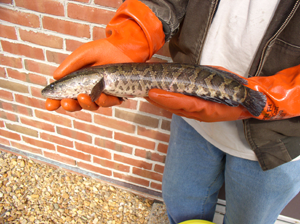|
Northern Snakehead Invasive specie |
||||||
| References: PRFC Orders and Policies #2010-06 Maryland Invasive Species Maryland Fishery Resources Office U.S. Geological Survey Virginia Dept.of Game and Inland Fisheries |
 |
|||||
THE POTOMAC RIVER FISHERIES COMMISSION, having considered the protection, promotion, growth and conservation of the indigenous seafood resources, and pursuant to its authority under Regulation I, Section 7(a) (1) and Section 8 (a), HEREBY DECLARES AND ORDERS:
AND IT IS FURTHER DECLARED AND ORDERED: this Order 2010-06 shall become effective June 20, 2010 and remain in effect until further notice. |
||||||
|
Credits: Article Publishes by Virginia Department of Game and Inland Fisheries Northern Snakehead - Frequently Asked Questions Snakehead Fish Caught in the Potomac River and its Tributaries: Northern snakeheads have been documented in the Potomac River from Great Falls downstream for almost 100 miles to near the Chesapeake Bay. Although they have been found in the nontidal section of the Potomac and its tributaries above Washington, D.C., most snakeheads are still found in the tidal waters from D. C. downstream to Colonial Beach (and in tributaries of D.C., Maryland and Virginia within this reach). Snakeheads are abundant in all of Virginia's tidal tributaries to the Potomac River within this reach (e.g., Little Hunting Creek, Dogue Creek, Pohick Creek, Occoquan River, Neabsco Creek, Quantico Creek, and Aquia Creek). Sampling continues along Virginia's Potomac River shoreline and within tidal tributaries. Virginia Department of Game and Inland Fisheries biologists regularly sample a large portion of the Commonwealth's waters using a variety of methods and have not found snakeheads outside of the Potomac drainage, although one dead snakehead was found near a boat landing in Accomack County on the Eastern Shore across the Bay from the mouth of the Potomac River. The origin of this fish remains unclear.  What should someone do if they think they've found a snakehead fish? Before going fishing, anglers should familiarize themselves with the fish species found in Virginia. There are several native species including bowfin, lamprey, and American eel that look similar to the northern snakehead. For more information and assistance with learning the identifying differences between snakehead fish and native species, please see our "Do You Know The Difference?" information page. Any unusual fish needs to be reported to the Virginia Department of Game and Inland Fisheries. We have established a snakehead hotline that anglers can use to report snakehead fish (804-367-2925). Anglers are not required to report snakeheads nor are they required to kill them if caught, but the Department asks that the fish be reported and killed if possible. However, if an angler wishes to keep a legally caught northern snakehead, the fish must be killed to be in possession, and the angler must call the hotline and report the angler's last name, date of catch, location of catch and size. Kill the fish by:
Is it illegal to own a snakehead fish in Virginia? Yes, it is illegal to own one without a permit. In 2002, the Board of Game and Inland Fisheries added the snakehead fish to the list of predatory and undesirable exotic species, making it illegal to possess a snakehead fish in Virginia without a permit issued by the Department of Game and Inland Fisheries. Federal regulations enacted in October 2002 prohibit the importation of snakehead fish into the United States and prohibit interstate transport of these animals. Individuals who still own a live snakehead need to contact the Department of Game and Inland Fisheries immediately for proper disposal of the fish. Effective July 1, 2005, anglers who legally catch a snakehead may keep the fish to mount or eat providing they:
What will the Department do now that snakeheads have been found in Virginia? Biologists continue to sample snakehead-colonized waters in an effort to learn more about the ecology and biology of this exotic fish in Virginia. Migration, exploitation, food habits, growth, and behavior of northern snakeheads are being studied; and attempts are being made to determine what impacts, if any, are occurring to aquatic communities as a result of colonization. The Department has membership on the U. S. Fish and Wildlife Service's National Snakehead Control and Management Plan (SCMP) Work Group. This group assembled and submitted recommendations to the U. S. Congress. What kind of impact could a snakehead population have in Virginia? Exotic species like snakeheads can disrupt natural aquatic systems and may have significant impacts by feeding on and competing with native and/or naturalized fishes. In addition, they may transmit parasites and diseases to native wildlife in those systems. Do we have to be concerned about snakehead fish appearing in the James River, Rappahannock River, or other waters in Virginia? Yes. While snakeheads are freshwater fish, it has been determined that they can tolerate a fairly high level of salinity (this is especially true for juveniles with lower water temperatures). They may be able to colonize other drainages through extreme storm events riding freshets or by illegal introductions. Are snakehead fish dangerous? While northern snakeheads do not attack humans or small pets, they may present threats to our native and/or naturalized wildlife and ecosystems. The Virginia Department of Game and Inland Fisheries wants anglers to be aware of the identifying features of the species they are catching and to report any unusual fish caught. Call the Department's in-state toll-free number, 1-800-770-4951. Anyone who still has a snakehead fish needs to contact the Department of Game and Inland Fisheries immediately and SHOULD NOT to release it into the wild. Call the toll-free number, 1-800-770-4951, and VDGIF will assist in the proper disposal of the fish. For additional information: See: •Odenkirk, J. and S. Owens. 2007. Expansion of a northern snakehead population in the Potomac River system. Transactions of the American Fisheries Society 136:1633-1639. •Odenkirk, J. and S. Owens. 2005. Northern Snakeheads in the tidal Potomac River system. Transactions of the American Fisheries Society 134: 1605-1609. Available online from www.fisheries.org. |
||||||
| -Return to top of page- | ||||||
 |
|
